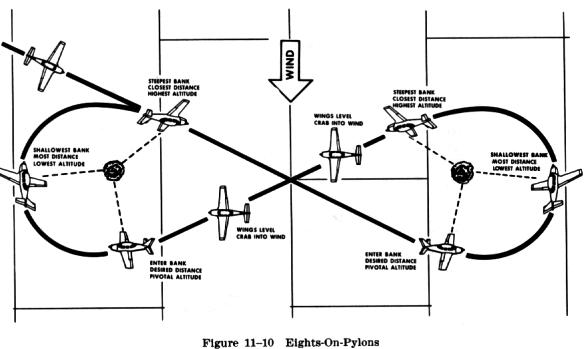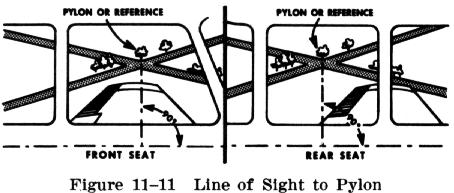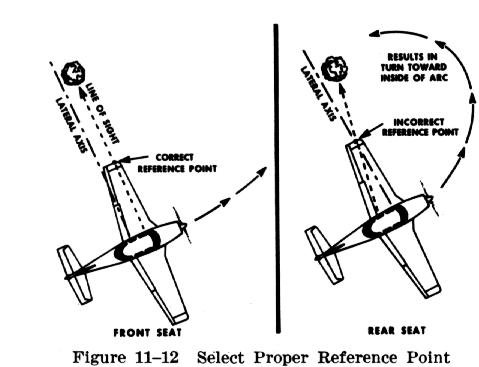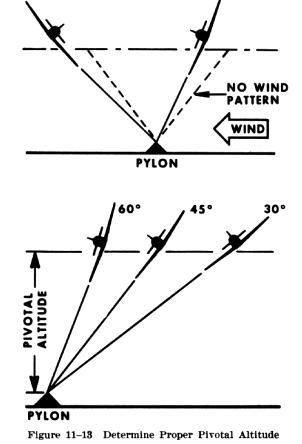
This training maneuver also involves flying the airplane in circular paths, alternately left and right, in the form of a figure "8" around two selected points or "pylons" on the ground. In this case, however, no attempt is made to maintain a uniform distance from the pylon. Instead, the airplane is flown at such an altitude and airspeed that a line parallel to the airplane's lateral axis, and extending from the pilot's eye appears to pivot on each of the pylons (Fig. 11-10). The altitude which is appropriate for the airplane being flown is called the "pivotal altitude" and is governed by the groundspeed. While not truly a ground track maneuver as were the preceding maneuvers, the objective is similar - to develop the ability to maneuver the airplane accurately while dividing one's attention between the flightpath and the selected points on the ground.

In explaining the performance of eights on pylons the term "wingtip" is frequently considered as being synonymous with the proper reference line, or pivot point on the airplane. This interpretation, however, is not always correct. High wing, low wing, swept wing and taper wing airplanes, as well as those with tandem or side by side seating, will all present different angles from the pilot's eye to the wingtip (Fig. 11-11). Therefore, in the correct performance of eights on pylons, as in other maneuvers requiring a lateral reference, the pilot should use a sighting reference line which, from eyelevel, parallels the lateral axis of the airplane.

The sighting point or line, while not necessarily on the wingtip itself, may be positioned in relation to the wingtip (ahead, behind, above, or below); but even then it will differ for each pilot, and from each seat in the airplane. This is especially true in tandem (fore and aft) seat airplanes. However, in side by side type airplanes, there will be very little variation in the sighting lines for different persons if those persons are seated so that the eyes of each are at approximately the same level.
An explanation of the pivotal altitude is also essential. There is a specific altitude at which, when the airplane turns at a given groundspeed, a projection of the sighting reference line to the selected point on the ground will appear to pivot on that point. Since different airplanes fly at different airspeeds, the groundspeed will be different (Fig. 11-12). Hence, each airplane will have its own pivotal altitude. The pivotal altitude does not vary with the angle of bank being used unless the bank is steep enough to affect the groundspeed.

The angle of bank is affected by the distance from the pylon. At any altitude above that pivotal altitude, the projected reference line will appear to move rearward in a circular path in relation to the pylon. Conversely, when the airplane is below the pivotal altitude, the projected reference line will appear to move forward in a circular path.
To demonstrate this, the airplane is flown at normal cruising speed at an altitude estimated to be below the proper pivotal altitude, and then placed in a medium banked turn. It will be seen that the projected reference line of sight appears to move forward along the ground as the airplane turns.
A climb is then made to an altitude well above the pivotal altitude, and when the airplane is again at normal cruising speed, it is placed in a medium banked turn. At this higher altitude, the projected reference line of sight now appears to move backward across the ground in a direction opposite that of flight.
After the high altitude extreme has been demonstrated, the power is reduced, and a descent at cruising speed begun in a continuing medium bank around the pylon. The apparent backward travel of the projected reference line with respect to the pylon will slow down as altitude is lost, stop for an instant, then start to reverse itself, and would move forward if the descent were allowed to continue below the pivotal altitude.
The altitude at which the line of sight apparently ceased
to move across the ground was the pivotal altitude. If the airplane descended
below the pivotal altitude, power should be added to maintain airspeed
while altitude is regained to the point at which the projected reference
line moves neither backward nor forward but actually pivots on the pylon.
In this way the pilot can determine the pivotal altitude of the airplane
(Fig. 11-13).
 |
The pivotal altitude is critical and will change with variations in
groundspeed. Since the headings throughout the turns continually vary from
directly downwind to directly upwind, the groundspeed will constantly change.
This will result in the proper pivotal altitude varying slightly throughout
the eight. Therefore, adjustment must be made for this by climbing or descending
as necessary to hold the reference line or point on the pylons. This change
in altitude will be dependent on how much the wind affects the groundspeed.
Before beginning the maneuver, select two points on the ground along a line which lies 90 degrees to the direction of the wind. The area in which the maneuver is to be performed should be checked for obstructions and any other air traffic, and it should be located where a disturbance to groups of people, livestock, or communities will not result. The selection of proper pylons is of importance to good eight on pylons. They should be sufficiently prominent to be readily seen by the pilot when completing the turn around one pylon and heading for the next, and should be adequately spaced to provide time for planning the turns and yet not cause unnecessary straight and level flight between the pylons. Approximately 3 to 5 seconds of straight and level flight should be sufficient for checking the area properly before entering the next turn. |
For uniformity, the eight is usually begun by flying diagonally crosswind between the pylons to a point downwind from the first pylon so that the first turn can be made into the wind.
As the airplane approaches a position where the pylon appears to be just ahead of the wingtip, the turn should be started by lowering the upwind wing to place the pilot's line of sight reference on the pylon. As the turn is continued, the line of sight reference can be held on the pylon by gradually increasing the bank. The reference line should appear to pivot on the pylon. As the airplane heads into the wind, the groundspeed decreases; consequently the pivotal altitude is lower and the airplane must descend to hold the reference line on the pylon. As the turn progresses on the upwind side of the pylon, the wind becomes more of a crosswind and drifts the airplane closer to the pylon. Since a constant distance from the pylon is not required on this maneuver, no correction to counteract drifting should be applied. Therefore, with the airplane drifting closer to the pylon, the angle of bank must be increased to hold the reference line on the pylon.
If the reference line appears to move ahead of the pylon, the pilot should increase altitude. If the reference line appears to move behind the pylon, the pilot should decrease altitude. Varying rudder pressure to yaw the airplane and force the wing and reference line forward or backward to the pylon is a dangerous technique and must not be attempted.
As the airplane turns toward a downwind heading, the rollout from the turn should be started to allow the airplane to proceed diagonally to a point on the downwind side of the second pylon. The rollout must be completed in the proper crab angle to correct for wind drift, so that the airplane will arrive at a point downwind from the second pylon the same distance it was from the first pylon at the beginning of the maneuver.
Upon reaching that point, a turn is started in the opposite
direction by lowering the upwind wing to again place the pilot's line of
sight reference on the pylon. The turn is then continued just as in the
turn around the first pylon but in the opposite direction.
The most common error in attempting to hold a pylon is
incorrect use of the rudder. When the projection of the reference line
moves forward with respect to the pylon, many pilots will tend to press
the inside rudder to yaw the wing backward; when the reference line moves
behind the pylon they will press the outside rudder to yaw the wing forward.
The rudder is to be used only as a coordination control.
The eights on pylons is an advanced training maneuver that provides practice in developing coordination skills while the pilot's attention is directed at maintaining a pivotal position on a selected pylon.